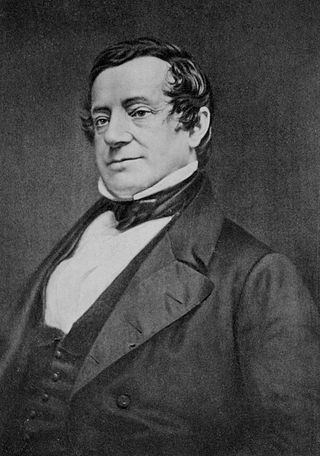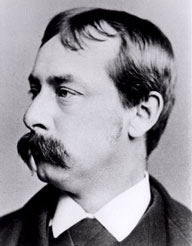Related Research Articles

Washington Irving was an American short-story writer, essayist, biographer, historian, and diplomat of the early 19th century. He wrote the short stories "Rip Van Winkle" (1819) and "The Legend of Sleepy Hollow" (1820), both of which appear in his collection The Sketch Book of Geoffrey Crayon, Gent. His historical works include biographies of Oliver Goldsmith, Muhammad, and George Washington, as well as several histories of 15th-century Spain that deal with subjects such as the Alhambra, Christopher Columbus, and the Moors. Irving served as American ambassador to Spain in the 1840s.

Francis Pharcellus Church was an American publisher and editor. In 1897, Church wrote the editorial "Yes, Virginia, there is a Santa Claus". Produced in response to eight-year-old Virginia O'Hanlon's letter asking whether Santa Claus was real, the widely republished editorial has become one of the most famous ever written.

Sleepy Hollow is a 1999 gothic supernatural horror film directed by Tim Burton. It is a film adaptation loosely based on Washington Irving's 1820 short story "The Legend of Sleepy Hollow", and stars Johnny Depp and Christina Ricci, with Miranda Richardson, Michael Gambon, Casper Van Dien, Christopher Lee and Jeffrey Jones in supporting roles. The plot follows police constable Ichabod Crane (Depp) sent from New York City to investigate a series of murders in the village of Sleepy Hollow by a mysterious Headless Horseman.

Sleepy Hollow is a village in the town of Mount Pleasant, in Westchester County, New York, United States. The village is located on the east bank of the Hudson River, about 30 miles (48 km) north of New York City, and is served by the Philipse Manor stop on the Metro-North Hudson Line. To the south of Sleepy Hollow is the village of Tarrytown, and to the north and east are unincorporated parts of Mount Pleasant. The population of the village at the 2020 census was 9,986.

Sleepy Hollow Cemetery in Sleepy Hollow, New York, is the final resting place of numerous famous figures, including Washington Irving, whose 1820 short story "The Legend of Sleepy Hollow" is set in the adjacent burying ground at the Old Dutch Church of Sleepy Hollow. Incorporated in 1849 as Tarrytown Cemetery, the site posthumously honored Irving's request that it change its name to Sleepy Hollow Cemetery. It was listed on the National Register of Historic Places in 2009.

"The Legend of Sleepy Hollow" is an 1820 short story by American author Washington Irving, contained in his collection of 34 essays and short stories titled The Sketch Book of Geoffrey Crayon, Gent. Irving wrote the story while living in Birmingham, England.

Tarrytown is a village in the town of Greenburgh in Westchester County, New York. It is located on the eastern bank of the Hudson River, approximately 25 miles (40 km) north of Midtown Manhattan in New York City, and is served by a stop on the Metro-North Hudson Line. To the north of Tarrytown is the village of Sleepy Hollow, to the south the village of Irvington and to the east unincorporated parts of Greenburgh. The Tappan Zee Bridge crosses the Hudson at Tarrytown, carrying the New York State Thruway to South Nyack, Rockland County and points in Upstate New York. The population was 11,860 at the 2020 census.

Robert Livingston the Elder was a Scottish-born merchant and government official in the Province of New York. He was granted a patent to 160,000 acres of land along the Hudson River, becoming the first lord of Livingston Manor.

Stephanus van Cortlandt was the first native-born mayor of New York City, a position which he held from 1677 to 1678 and from 1686 to 1688. He was the patroon of Van Cortlandt Manor and was on the governor's executive council from 1691 to 1700. He was the first resident of Sagtikos Manor in West Bay Shore on Long Island, which was built around 1697. A number of his descendants married English military leaders and Loyalists active in the American Revolution, and their descendants became prominent members of English society.
Samuel Youngs was an American school teacher. He was a friend of Washington Irving and elements of his life may be included in the character Ichabod Crane in Irving's story "The Legend of Sleepy Hollow", along with the character inspiration from Kinderhook Schoolteacher, Jesse Merwin.

Wolfert Acker (1667–1753) was a colonial-period American who is featured in Washington Irving's short story collection Wolfert's Roost and Miscellanies (1855). His name was recorded in all combinations of Wolfert or Wolvert as given name, and Acker, Echert, Eckar, or Ecker as surname. He was born in Flatbush, Brooklyn, New York and died at his sizable home, "Wolfert's Roost" near the site of what is now Irvington, New York in Westchester County, New York. On December 20, 1692, on land belonging to Frederick Philipse, he married Maretje Sibouts.

The Sketch Book of Geoffrey Crayon, Gent., commonly referred to as The Sketch Book, is a collection of 34 essays and short stories written by the American author Washington Irving. It was published serially throughout 1819 and 1820. The collection includes two of Irving's best-known stories, attributed to the fictional Dutch historian Diedrich Knickerbocker: "The Legend of Sleepy Hollow" and "Rip Van Winkle". It also marks Irving's first use of the pseudonym Geoffrey Crayon, which he would continue to employ throughout his literary career.

The Old Dutch Church of Sleepy Hollow (Dutch: Oude Nederlandse Kerk van Sleepy Hollow), listed on the National Register of Historic Places as Dutch Reformed Church (Sleepy Hollow), is a 17th-century stone church located on Albany Post Road (U.S. Route 9) in Sleepy Hollow, New York, United States. It and its three-acre (1.2 ha) churchyard feature prominently in Washington Irving's 1820 short story "The Legend of Sleepy Hollow". The churchyard is often confused with the contiguous but separate Sleepy Hollow Cemetery.

The Reformed Church of the Tarrytowns in Tarrytown, New York, serves both Tarrytown and Sleepy Hollow, New York. It was constructed in 1837 as an extension of the Old Dutch Church of Sleepy Hollow to serve the Tarrytown community.
Dirck Gorisszen Storm was an early colonial American who recorded the first official history of the Dutch community at Sleepy Hollow. His book Het Notite Boeck der Christelyckes Kercke op de Manner of Philips Burgh is a rare document of life in colonial times. Sometimes referred to as Het Notite Boeck, the five-part book is one of the few surviving records of Dutch Colonial American village life in English-occupied New York province.
Historic Hudson Valley is a not-for-profit educational and historic preservation organization headquartered in Tarrytown, New York. The organization runs tours and events at five historic properties in Westchester County, in the lower Hudson River Valley.
Het Notite Boeck der Christelyckes kercke op de Manner of Philips Burgh is a rare surviving record book of the Old Dutch Church of Sleepy Hollow in Sleepy Hollow, New York.

The Headless Horseman is a mythical figure who has appeared in folklore around Europe since the Middle Ages. The figure is traditionally depicted as a rider upon horseback who is missing his head.

The Pocantico River is a nine-mile-long (14 km) tributary of the Hudson River in western central Westchester County, New York, United States. It rises from Echo Lake, in the town of New Castle south of the hamlet of Millwood, and flows generally southwest past Briarcliff Manor to its outlet at Sleepy Hollow. Portions of the towns of Mount Pleasant and Ossining are within its 16-square-mile (41 km2) watershed.
Revier is a German word meaning area or territory.
References
- ↑ N.Y. Genealogical and Biographical Record 130 (October 1989): 214-15